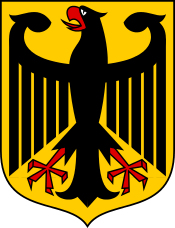Hellmuth Heye
| Hellmuth Heye | |
|---|---|
.jpg) | |
| Born |
9 August 1895 Beckingen |
| Died |
10 November 1970 (aged 75) Mittelheim |
| Allegiance |
|
| Service/branch |
|
| Years of service | 1914–45 |
| Rank | Admiral |
| Unit |
Victoria Louise Kaiserin Württemberg |
| Commands held | Admiral Hipper |
| Battles/wars |
|
| Awards | Knight's Cross of the Iron Cross |
| Relations | Wilhelm Heye (father) |
Hellmuth Guido Alexander Heye (9 August 1895 in Beckingen – 10 November 1970 in Mittelheim) was born on August 9, 1895, son of father, August Wilhelm Heye, and mother Else Karcher Heye. Hellmuth was a German admiral in World War II and politician in post-war Germany. He was also a recipient of the Knight's Cross of the Iron Cross (German: Ritterkreuz des Eisernen Kreuzes). The Knight's Cross of the Iron Cross was awarded to recognise extreme battlefield bravery or successful military leadership.
Naval career
Heye graduated from high school in Berlin in early 1914 and immediately joined the Imperial Navy. From April 1939 to September 1940 he commanded the Heavy Cruiser Admiral Hipper. While taking his ship to Trondheim in April 1940 to land invasion troops there (Operation Weserübung), he encountered the British destroyer Glowworm and sank it. Heye sent a message to the British Admiralty through the Red Cross praising the gallantry of Glowworm's commander and crew, and this contributed to LtCdr Gerard Roope receiving the earliest Victoria Cross of World War II, although the award was not made until 1945.[1]
In 1941 Heye was promoted to Vice Admiral, and from September to November 1942 he was commanding admiral of the German naval forces in the Black Sea. From April 1944 onward he was commanding admiral of the small naval combat forces, which included mini-submarines, combat divers, etc. He received the Knight's Cross of the Iron Cross on 18 January 1941.
Civilian career
After the war Heye published a number of works on naval strategy, history and warfare as a member of the Naval Historical Team. He subsequently advised the German government on issues concerning the establishment and organization of a new military. In 1953 he joined the centrist party CDU (Christian Democratic Union) of Chancellor Konrad Adenauer and represented this party in the Federal Parliament (Bundestag) from 1953 to 1961, elected for the district of Wilhelmshaven-Friesland.
On 8 November 1961 the Bundestag elected him unanimously as its Ombudsman for the Military (Wehrbeauftragter). In the autumn of 1964, Heye published a series of articles in the German news journal Quick, warning of a risk of the German military once again drifting into isolation from society at large. This triggered a vigorous and sharply worded debate between him and the ministry of defense. Frustrated by what he perceived to be inadequate support from Parliament, Heye resigned his position on 10 November 1964.[2]
Awards
- Iron Cross (1914)
- Friedrich August Cross, 2nd Class (14 February 1918)[3]
- U-boat War Badge (20 November 1926)[3]
- Wehrmacht Long Service Award
- 4th to 2nd Class (2 October 1936)[3]
- Commander of the Order of the Crown of Italy (13 December 1937)[3]
- Sudetenland Medal (22 May 1939)(2 October 1936)[3]
- Memel Medal (26 October 1939)(2 October 1936)[3]
- 1st Class (11 February 1939)[3]
- Clasp to the Iron Cross (1939)
- Knight's Cross of the Iron Cross on 18 January 1941 as Kapitän zur See and commander of heavy cruiser Admiral Hipper[4][5]
- High Seas Fleet Badge (16 February 1942)[3]
- Officer of the Order of the Crown of Romania (15 January 1943)[3]
References
Citations
Bibliography
- Dörr, Manfred (1995). Die Ritterkreuzträger der Überwasserstreitkräfte der Kriegsmarine—Band 1: A–K [The Knight's Cross Bearers of the Surface Forces of the Navy—Volume 1: A–K] (in German). Osnabrück, Germany: Biblio Verlag. ISBN 978-3-7648-2453-2.
- Fellgiebel, Walther-Peer (2000). Die Träger des Ritterkreuzes des Eisernen Kreuzes 1939–1945 — Die Inhaber der höchsten Auszeichnung des Zweiten Weltkrieges aller Wehrmachtteile [The Bearers of the Knight's Cross of the Iron Cross 1939–1945 — The Owners of the Highest Award of the Second World War of all Wehrmacht Branches] (in German). Friedberg, Germany: Podzun-Pallas. ISBN 978-3-7909-0284-6.
- Nietrug, Gerd (2004). Die Ritterkreuzträger des Saarlandes 1939 – 1945 [The Knight's Cross Bearers of the Saarland 1939 – 1945] (in German). Zweibrücken, Germany: VDM Nickel. ISBN 978-3-925480-93-5.
- Scherzer, Veit (2007). Die Ritterkreuzträger 1939–1945 Die Inhaber des Ritterkreuzes des Eisernen Kreuzes 1939 von Heer, Luftwaffe, Kriegsmarine, Waffen-SS, Volkssturm sowie mit Deutschland verbündeter Streitkräfte nach den Unterlagen des Bundesarchives [The Knight's Cross Bearers 1939–1945 The Holders of the Knight's Cross of the Iron Cross 1939 by Army, Air Force, Navy, Waffen-SS, Volkssturm and Allied Forces with Germany According to the Documents of the Federal Archives] (in German). Jena, Germany: Scherzers Militaer-Verlag. ISBN 978-3-938845-17-2.
External links
- Hellmuth Heye in the German National Library catalogue
- "Hellmuth Guido Heye". Deutscher Bundestag (in German). Retrieved 27 November 2012.
- "Heye und kleine Fische—Bonn". Der Spiegel (in German). 40. 1961. Retrieved 29 June 2013.
- "Hellmuth Heye". Der Spiegel (in German). 11. 1963. Retrieved 29 June 2013.
- "Der Fall Barth Die Geschichte der "Bier-Order 61"". Der Spiegel (in German). 12. 1963. Retrieved 29 June 2013.
- "Hellmuth Guido Alexander Heye". Der Spiegel (in German). 46. 1964. Retrieved 29 June 2013.
